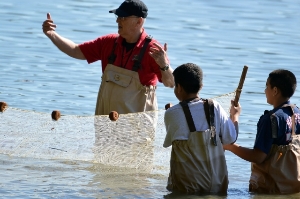- A group opportunity. Invite your friends.
-
21 people are interested
Monitor the Spread of Introduced Species in the Chesapeake
ORGANIZATION: Smithsonian Environmental Research Center
Please visit the new page to apply.
- A group opportunity. Invite your friends.
-
21 people are interested

The Smithsonian Environmental Research Center (SERC) needs your help to track the spread of introduced species throughout the Chesapeake Bay. To participate, you simply need to report sightings of either of the following species. The names of the species are linked to websites to tell you the best procedure to follow if you see them.
Mid-Atlantic Chinese Mitten Crabs
We seek your help to determine the current distribution status of the mitten crab in the region. Your report of new sightings is vital to understanding and possibly preventing the spread of this crab. The first confirmed record along the entire eastern United States, from Florida to Maine, was in the Chesapeake Bay near Baltimore, Maryland in 2005. This initial crab was reported by a commercial crabber. Many additional crabs have been confirmed since this time and nearly all have been reported by commercial and recreational fishermen. This crab can have negative ecological and economical impacts and is listed as Injurious Wildlife under the Federal Lacey Act, and understanding how they are spreading will allow us to mitigate their impacts.
Collaborate with scientists at the Smithsonian Environmental Research Center to help us track the expanding range of the non-native blue catfish into the upper Chesapeake Bay and into Delaware Bay and the Delaware River. Native to the Mississippi, Ohio and Missouri Rivers, blue catfish were introduced to Virginia for sport fishing beginning in 1974. Since introduction, these non-native top predators have expanded their range into many of Maryland’s tributaries, including the Nanticoke, Patuxent, Choptank, Susquehanna and Sassafras Rivers. Due to their large size and adult predatory feeding behavior, blue catfish are consuming many native fish species, such as white perch, largemouth bass, American shad, river herring and menhaden. Knowing where and when these catfish a re being caught is an important part of understanding their rising impact on the Chesapeake Bay ecosystem.
More opportunities with Smithsonian Environmental Research Center
2 ReviewsNo additional volunteer opportunities at this time.
About Smithsonian Environmental Research Center
Location:
647 Contees Wharf Road, Edgewater, MD 21037, US
Mission Statement
The Smithsonian Environmental Research Center (SERC) leads the Nation in research on linkages
of land and water ecosystems in the coastal zone and provides society with knowledge to meet critical environmental challenges
in the 21st century.
Description
The Smithsonian Environmental Research Center (SERC) is looking for people who are interested in participating in environmental science research. Volunteer opportunities can accommodate a variety of interests including working in the laboratory or the field on topics ranging from colonial archaeology to forest biodiversity to water quality. We are also looking for volunteers to assist in our education department and assist with activities like leading field trips and canoe excursions, helping in classrooms, and maintaining aquariums and gardens. No specific experience is required and all appropriate training will be provided.
CAUSE AREAS
WHEN
WHERE
various locationsEdgewater, MD 21037
DATE POSTED
March 21, 2016
SKILLS
GOOD FOR
- Kids
- Teens
- People 55+
- Group
REQUIREMENTS
N/A
